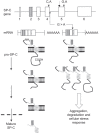Unravelling the progressive pathophysiology of idiopathic pulmonary fibrosis
- PMID: 22654088
- PMCID: PMC9487300
- DOI: 10.1183/09059180.00001012
Unravelling the progressive pathophysiology of idiopathic pulmonary fibrosis
Abstract
Idiopathic pulmonary fibrosis (IPF) is a life-threatening condition, with a median survival of <3 yrs. The pathophysiology is not fully understood, but chronic injury of alveolar epithelial type II cells (AECII) is considered key. In IPF, disturbed folding and processing of surfactant proteins and impaired DNA repair may represent underlying reasons for maladaptive endoplasmic reticulum stress responses, increased reactive oxygen species production and/or DNA damage. Excessive AECII apoptosis occurs, leading to permanently perturbed epithelial homeostasis. The role of secondary hits also becomes evident. These may aggravate the disease and result in increased epithelial turnover, exhausting the regenerative capacity of progenitors and disturbing epithelial-mesenchymal interactions. Fibroblast proliferation, transdifferentiation and matrix deposition may be mediated through various mechanisms including epithelial-mesenchymal transition, fibrocyte invasion or expansion of a local fibroblast population. Treatment modalities aiming to attenuate epithelial injury are currently in early pre-clinical development and may reach the clinical arena in only a few years. Meanwhile, novel drugs acting on highly activated fibroblasts such as pirfenidone, an anti-fibrotic drug authorised for IPF in the European Union, or BIBF 1120, a novel triple-kinase inhibitor (blocking vascular endothelial growth factor, platelet-derived growth factor and fibroblast growth factor) currently under clinical investigation, seem to attenuate the progression of IPF.
Conflict of interest statement
P. Markart has received fees for speaking from Roche and InterMune.
Figures







References
-
- American Thoracic Society, European Respiratory Society. American Thoracic Society/European Respiratory Society International Multidisciplinary Consensus Classification of the Idiopathic Interstitial Pneumonias. Am J Respir Crit Care Med 2002; 165: 277–304. - PubMed
-
- Orphanet Report Series–Prevalence of rare diseases. Bibliographic data. November 2011, Number 1.www.orpha.net/orphacom/cahiers/docs/GB/Prevalence_of_rare_diseases_by_al....
-
- Vancheri C, Failla M, Crimi N, et al. . Idiopathic pulmonary fibrosis: a disease with similarities and links to cancer biology. Eur Respir J 2010; 35: 496–504. - PubMed
Publication types
MeSH terms
Substances
LinkOut - more resources
Full Text Sources
Other Literature Sources
